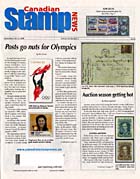
Canadian Stamp News
Sep 2, 2008
by Peter Butler, FRPSC for The Canadian Stamp News.
Grassroots Philately
Canadian Stamp News, September 2, 2008 issue
The saga of “soaking” self-adhesives continues!
If you have followed the debate in the philatelic press over the last few years about how to remove self-adhesive stamps from envelopes, here is another installment. “Soaking” is the operative word because traditionally, that’s how we have all removed used stamps from paper. Personally, I have tried all the methods advocated in the press but none have worked to my satisfaction. Therefore, I decided some time ago, to trim the paper to a few millimeters from the stamp and mount the en piece in my albums.
Collectors of US used stamps have ceased to collect them because of the problem. Others have ended their collections at 2000 or some other convenient date, so as not to have to worry about self-adhesives. Some have decided to switch their collections to mint stamps only.
In the July [2008] issue of the American Philatelist, I saw a letter, this time suggesting the use of a chemical and an eye-dropper. I was intrigued by the suggestion and decided to give it a try. It worked so well that I thought I would share the process the process and the materials with readers.
The process involves a chemical named, “Bestine” which is made by Union Rubber Incorporated from Newark, New Jersey. Bestine is a hydrocarbon and its main ingredient is heptane, for those interested in the chemistry, which evaporates quickly, leaves no residue and has no side effects have been found so far. It was formulated for thinning rubber cement originally and has been reformulated to also remove inks, decals and labels from all types of surfaces. It does not dissolve plastics.
Bestine is sold in small cans across Canada, close to where you’ll find rubber cement and rubber cement thinner.
As William Winter, from Silver Spring, Maryland, the writer of the Letter to APS, wrote, “I borrowed an eyedropper and the container of baby powder from the medicine cabinet and retired to the workshop to run the experiment.”
Here is his procedure. First, trim the envelope close to the stamp, turn it over and using an eye-dropper, squeeze a small amount of the liquid onto the paper surface. It quickly moistens the entire piece of paper and within 10 seconds you are able to peal the stamp away from the opposite side of the paper. Next, I placed the stamp face down, on newspaper and let it dry. There is a small residue of gum that remains on the stamp long after the liquid has evaporated. I then dusted the stamp with talc and amazingly, the stickiness disappeared.
Here’s what sold me on the process, there is no curling of the stamp as a result of the removal from the paper. It remains flat. I applied a hinge to the stamp to see if it adhered to the stamp and it did. As William Winter suggested, the chemical does not damage stamps, even ones that are printed on foil or embossed paper as regular soaking with water often does. I plan to use it on my American stamps that await, “soaking”.
